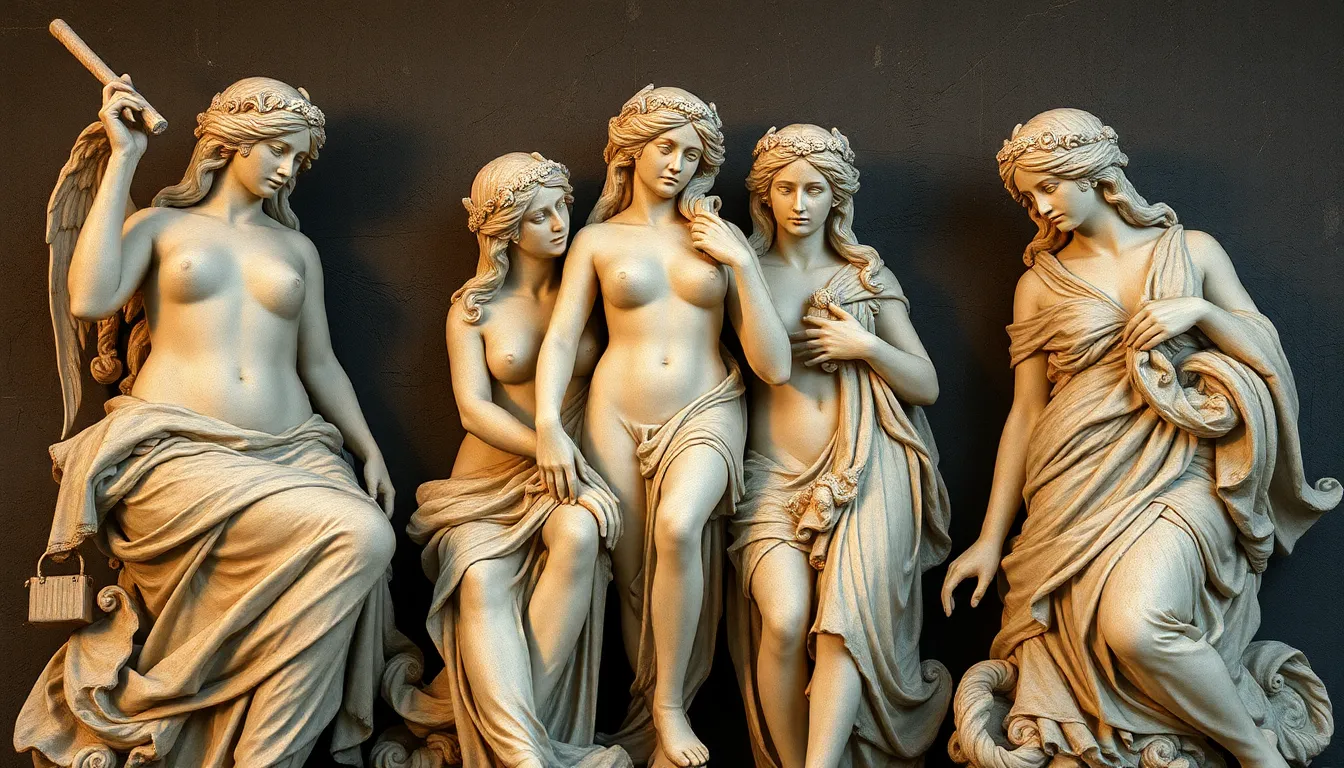The Muses and Their Representation in Modern Art
I. Introduction
The Muses, in classical mythology, are the nine goddesses who preside over the arts and sciences. Each Muse is responsible for a specific domain of human knowledge and creativity, inspiring artists, writers, and scholars throughout history. Their significance in art and culture cannot be overstated, as they have served as the embodiment of inspiration and artistic pursuit.
This article aims to explore the modern representations of the Muses in contemporary art, examining how these ancient figures have evolved and adapted to reflect current artistic trends and societal values.
II. Historical Context of the Muses
The origins of the Muses can be traced back to ancient Greece, where they were worshipped as the divine sources of artistic inspiration. Traditionally, they were identified as:
- Calliope (epic poetry)
- Clio (history)
- Erato (lyric poetry)
- Euterpe (music)
- Melpomene (tragedy)
- Polyhymnia (sacred poetry)
- Terpsichore (dance)
- Thalia (comedy)
- Urania (astronomy)
Over time, the representation of the Muses evolved through various art movements, from the classical works of ancient Greece and Rome to the Renaissance, where they were often depicted in paintings alongside notable figures of the time. The Romantic period further expanded their portrayal, emphasizing emotional depth and the personal connection between the artist and the Muses.
III. The Muses in Modern Art: An Overview
The transition from classical to modern interpretations of the Muses reflects broader changes in artistic expression and societal values. Contemporary artists often focus on key themes such as:
- The intersection of art and identity
- Feminism and the representation of women
- The role of inspiration in the creative process
Today, the Muses continue to serve as symbols of inspiration, encouraging artists to explore new ideas and innovative forms of expression.
IV. Notable Modern Artists and Their Depictions of the Muses
Several modern artists have explored the concept of the Muses in their work. Notable figures include:
- Pablo Picasso: Often depicted Muses through abstract forms, emphasizing emotional expression over literal representation. His works challenge traditional aesthetics, inviting viewers to engage with the essence of creativity.
- Frida Kahlo: Her self-portraits frequently feature symbolic representations of her personal struggles and inspirations, presenting a deeply personal interpretation of the Muses that reflects her identity and experiences.
- Georgia O’Keeffe: Known for her floral paintings and landscapes, O’Keeffe’s work is often interpreted as a reflection of the feminine spirit and the Muse as a source of artistic inspiration.
These artists utilize diverse techniques and styles, from cubism to surrealism, to convey their interpretations of the Muses, often infusing their work with personal narratives that resonate with broader themes of creativity and identity.
V. The Muses Across Different Mediums
The representation of the Muses is not confined to visual art; they have also made their way into various other mediums:
- Visual Art: Artists continue to explore the Muses through painting, sculpture, and installation, often using modern techniques and materials to reinterpret their essence.
- Performance Art and Dance: The Muses inspire choreographers and performers, with many contemporary dance pieces exploring themes of inspiration and the creative process.
- Literature and Music: Writers and musicians frequently invoke the Muses in their work, using them as metaphors for inspiration and creativity, reflecting on their own artistic journeys.
VI. The Role of Gender and Identity in Representing the Muses
Feminist perspectives have significantly influenced the representation of the Muses in modern art. The Muses, traditionally seen as passive sources of inspiration, are increasingly portrayed as empowered figures who embody creativity and strength.
Contemporary artists explore issues of identity and diversity, using the Muses to challenge conventional narratives and highlight marginalized voices. This shift reflects a broader cultural context that values inclusivity and representation in the arts.
VII. The Muses in Contemporary Society
In today’s cultural landscape, the Muses remain relevant as symbols of creativity and empowerment. Modern artists draw inspiration from the Muses to create works that comment on social issues, including:
- Gender equality
- Cultural identity
- Environmental concerns
By using the Muses as a framework for their artistic expression, contemporary creators continue to explore the dynamic relationship between inspiration and societal change.
VIII. Conclusion
The Muses have left an enduring legacy in the realm of art, inspiring generations of artists across cultures and time periods. As representations of creativity, they have evolved to reflect changing societal values and artistic movements.
In reflecting on the modern interpretations of the Muses, it is clear that they will continue to play a vital role in artistic expression and culture. As artists navigate the complexities of identity, social justice, and creative inspiration, the Muses will undoubtedly remain at the heart of the artistic journey.




